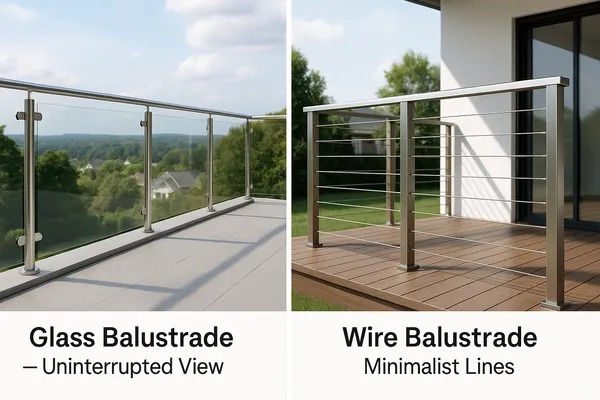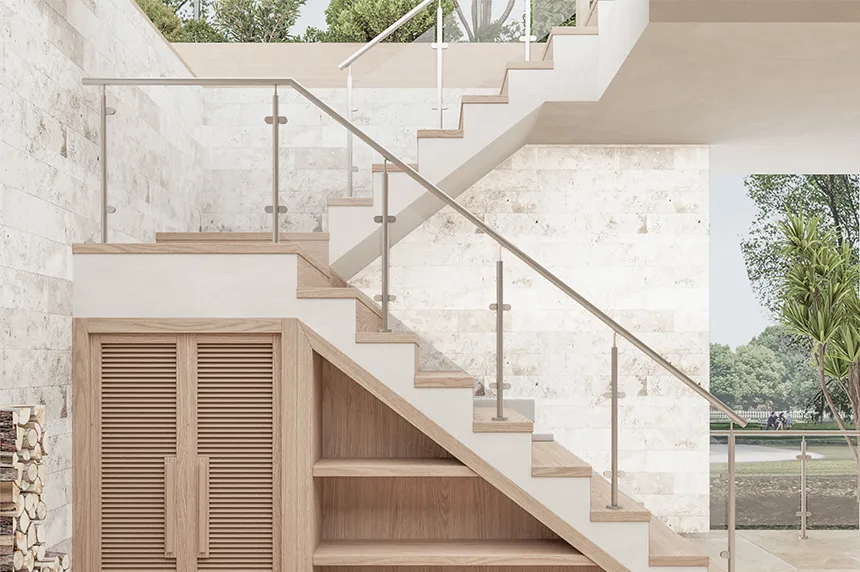You need a safe, attractive balustrade, but the choices feel endless. Pick wrong and you’ll fight cleaning, corrosion, and code issues. This guide breaks down glass vs wire so you can buy once, install right, and enjoy for years.
A glass balustrade uses toughened or laminated glass panels to create a solid barrier and an unobstructed view with strong visual appeal, while a wire balustrade uses stainless steel wire rope between posts for airflow, a lighter look, and easier maintenance. Both meet safety and compliance when engineered to code; choose based on design, site, and budget.
Als professioneller Hersteller und Exporteur von rostfreiem Stahl mit Sitz in China, we supply posts, fittings, and complete rostfreier Stahl kits for both systems. Below, I’ll show how each Balustrade performs in real projects for distributors, fabricators, OEMs, and developers—so you can choose the right specification with confidence.
A glass balustrade uses toughened glass oder laminated glass glass panels fixed to posts or base channels. The effect is a solid barrier with a near unobstructed view that floods spaces with natural light. In contrast, a wire balustrade strings wire rope between posts—think slim cables—so the eye reads empty space and open air.
From an installer’s angle, glass is heavier and needs careful handling; wire rope balustrade is lighter, faster, and more forgiving on irregular runs. For high-rise balconies or wind-exposed decks, glass balustrades offer better wind break; wire balustrades offer airflow and a subtle profile.
Quick scorecard (5 = excellent)
Transparency: Glass 5/5 | Wire 3/5
Airflow: Glass 2/5 | Wire 5/5
Cleaning: Glass 3/5 | Wire 5/5
Cost: Glass 3/5 | Wire 4/5
Installation speed: Glass 3/5 | Wire 5/5
For ready-to-install hardware, see our stainless steel wire balustrade components und Geländersysteme aus rostfreiem Stahl.

In marine or industrial environments, posts and fittings made from stainless steel (often 304 or 316) are vital. Glass edges and hardware must be korrosionsbeständig, and cable fittings should be high-grade stainless steel wire. With glass, glass panels need periodic cleaning with glass cleaner; with wire, you’ll check tension and end fittings annually.
Dauerhaftigkeit also ties to engineering. A well-specified balustrade system—correct post spacing, anchoring, and cable tension—keeps structural integrity over time. And if you want a darker tone, posts can be powder coated to ergänzen façade materials without sacrificing Haltbarkeit.
For coastal decks and balconies, our Edelstahl-Treppengeländer range is optimized for harsh weather.
Wählen Sie eine wire rope solution when you want airflow, minimal visual mass, and quick installation over long runs. A wire rope balustrade shines on decks, boardwalks, and Geländer lines that need curves or corners. The appearance of wire reads light and modern, and the system is often more affordable than glass to fabricate and ship.
Wire balustrade systems are versatile: vertical, horizontal, or angled for stairs. Many specifiers pick stainless steel or aluminium posts with swaged or swageless terminals. For long coastal runs, stainless steel wire rope systems handle wind and salt better than painted alternatives.
Explore our Handlauf aus rostfreiem Stahlrohr options to pair with cables on stairs.
If you want a high-end, sleek edge, go glass. Frameless glass or a frameless glass balustrade with channels creates a continuous plane—no pickets—delivering that unobstructed hotel-lobby vibe. Glass balustrades have panels that create visual calm and a contemporary look, ideal for showrooms, malls, and luxury residences.
For safety, specify tempered glass oder safety glass, and set the thickness of the glass per span and load (e.g., 10–15 mm typical in many markets). You can toughen edges (manufacturers may toughen after cutting and drilling) and add a top cap handrail if code or usage demands. Glass options range from clear to frosted tints; you can keep the glass spotless with scheduled maintenance.
See inspiration on Glasbalustrade Treppe for interior atriums and mezzanines.

Safety and compliance come first. Most jurisdictions set minimum heights, maximum gap sizes, and specific load ratings for infill and top rails. Balustrades provide fall protection; they’re a core safety feature on stairs, landings, and terraces. Glass lines may need toughened glass panels oder laminated glass for retention. Cables must meet deflection limits so children can’t climb or slip through.
Always check local rules (e.g., IBC/ICC, BS 6180, AS/NZS standards). For reference, see general overviews from the International Code Council and guidance summaries like UK Approved Document K. Codes vary; balustrades may require special anchoring on edge conditions or wind-rated zones.
Match your spec with our Handlauf aus rostfreiem Stahl families for fully compliant stair runs.
On aesthetics, glass railings win when you need a pristine gallery vibe, contemporary look and feel, and daylight continuity. They support visual appeal and views. Cable lines bring an industrial look and, in some projects, an industrial look and feel that pairs well with timber decking and steel.
This is the heart of glass vs cable: do you want the bold statement of clear planes, or the near-invisible geometry of lines? Use glass in areas where unobstructed view matters most; choose wire and glass mixes where budget and airflow also matter. For classic settings, traditional wooden balustrades still have a place; for modern edges, metal balustrades dominate.
For mixed-use interiors, see our Edelstahlgeländer für Balkone ideas that also offer privacy options.
Inside, both systems shine. Outside, salt, rain, and sun make materials choice critical. A Stahlbalustrade in 316 grade offers excellent baseline protection, and post surfaces can be brushed or powder coated. For open decks indoor or outdoor, cables shed water and dust better; glass stops wind but shows spots after storms.
Hybrid glass and wire balustrade layouts work well: glass near seating for wind, cables on returns for cross-ventilation. Remember, balustrades are also part of the façade—pick finishes that ergänzen cladding and landscaping.

Cable infill is frequently “more affordable than glass” because you ship posts and wire rope coils, not sheets and crates. The lighter weight lowers freight and eases handling. Fabricators like that cable runs allow field adjustments; glass or wire decisions affect schedule as much as budget.
That said, glass costs vary with thickness of the glass, edge polishing, and fixings. A glass balustrade system with standoff fittings is beautiful, but more labor-intensive. For quick retrofits and long terraces, wire balustrade systems reduce install time. When budgets are tight, prioritize spans and sightlines—reserve premium glass for signature areas.
There are different types of balustrades beyond glass and cable: wooden balustrades, rod infill, perforated panels, and mixed media. Balustrades can also include privacy glass, mesh, or vertical bars to meet special project needs. For marine boardwalks, rostfreier Stahl cable remains a favorite; in lobbies, frameless or post-mounted glass dominates.
Remember that balustrades can be customised—post shapes, cap rails, bracket styles, and infill patterns. Many kits are made from stainless steel with optional caps or timber tops to soften the line for traditional and modern interiors alike.
When choosing the right balustrade, ask:
Right balustrade decisions balance people, place, and price. Talk early with your fabricator so details like anchoring, drainage, and expansion joints get drawn into the balustrading package.
A seaside apartment complex replaced rusting painted rails with stainless steel wire balustrades. Posts in 316 with concealed bases and stainless steel wire infill transformed wind-whipped decks. The system stayed korrosionsbeständig after storm season; cleaning was quick compared to salt-spotted glass.
On the penthouse, designers used a short run of glass near lounge seating for wind protection. The team specified laminated glass lite sizes small enough for easy handling, proving glass balustrades are also practical when planned carefully.
“Glass balustrades vs cable? Think views vs airflow. Glass balustrades vs wire becomes easy when you map zones where people sit or stand.”
For stairs and transitions, explore our stainless steel handrail solutions and interior Glasbalustrade Treppe ideas.
| Faktor | Glass Balustrade | Wire Balustrade |
|---|---|---|
| View | Am besten unobstructed view; balustrades have panels that create a wind break | Open sightlines; slight visual lines |
| Reinigung | Needs routine washing; cleaning with glass cleaner | Occasional wipe; check tension |
| Kosten | Higher; varies by glass options and hardware | Often lower; lighter freight |
| Wind | Great wind shield; balustrades are great on rooftops | Air passes through |
| Style | Museum-grade contemporary look | Minimal industrial look |
| Install | Heavier lifts; precise | Faster; flexible runs |
Tip: In mixed developments, balustrades can be customised per elevation—glass at lounges, cable at corridors.
Are cable infills safe for kids and pets?
Yes—when engineered to code. Spacing, tension, and height all matter. A properly installed wire rope balustrade meets guardrail loads and spacing limits; your engineer will confirm deflection and terminal strength.
Will glass scratch or break easily?
Modern safety glass is tough. Glass balustrades have panels designed to resist everyday loads; where required, laminated glass retains fragments. If impact risk is high, discuss glass options and top caps.
Can I mix systems—glass and wire—in one project?
Absolutely. Designers often combine them: cable runs for long distances, glass for wind control. That’s the essence of glass and wire strategy.
What finishes pair best with timber decks?
Brushed 316 rostfreier Stahl posts and cable are timeless with wood. Glass is beautiful too, but expect more cleaning near trees or seaspray.
Which system lasts longer in harsh weather?
Both last when specified right. The key is grade, fixing detail, and maintenance. In coastal air, 316 posts and fittings fight Korrosion; glass needs scheduled washing to keep the glass clear.
Is glass difficult to service?
Not with a plan. Note the thickness of the glass, access routes, and anchors in the as-builts so replacements are straightforward.
P.S. If you’re comparing glass balustrades vs cable for a mixed-use property, we’re happy to share cut sheets, samples, and shop-drawing support for distributors, fabricators, and project teams.
What Is the Cost of Stainless Steel 304 Railing Pipe? Price per Meter, ASTM A312, Fittings, and Supplier Checklist
Rostet ein Edelstahlgeländer?Rost auf einem Edelstahlgeländer vorbeugen
Was ist der Unterschied zwischen einem Glasgeländer und einem Drahtgeländer?
Was ist ein geschweißtes Rohr? Geschweißtes vs. nahtloses Rohr erklärt